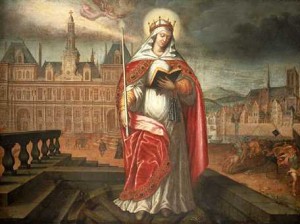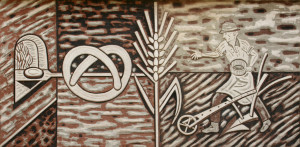
NINTH DAY of CHRISTMAS
St. Genevieve’s Day
We’re getting to the home stretch. Many people by now are a little sick of Christmas and it’s not unusual, especially this weekend, to see spent Christmas trees tossed out unceremoniously on the side of the road. Our neighbor Old Mr. Solderholm, a staunch yet grumpy traditionalist, once punched another neighbor of ours square in the nose for setting his tree out at the curb too soon. Granted it was only the day after Christmas and there were, to be sure, other things going on between them, but punching a man in the nose is a bit further than I care to go for my traditions. Still, though Mr. Solderholm and I rarely see things the same way, I do feel a certain kinship with him at times. It is a sad sight to see a Christmas tree on the curb like rubbish, but even more so when the yuletide season is not yet over.
Whether your Christmas celebration is a religious or a secular one, there is a traditional ending to both: the sixth day of January. The odd thing about all this is that if you are amongst those who celebrate through that date, you are in the minority. So if you are still celebrating, as we in this house are still celebrating, well… welcome to the counter culture.
Even here in the Christmas counter culture there are many matters of debate. This, I think, is because Christmas has such a long history and is connected to customs both religious and secular (and indeed customs that predate Christianity itself). It is a bit of a paradox. One of the things I’d like to address here is that I have given you one system of counting these Twelve Days of Christmas, but ask other people and you will get other systems. The fact is that there is more than one way to count the Twelve Days of Christmas. To be sure, over the centuries it’s become a muddled mess. Ask people in the Church, and you will probably find their days one off from the version you’re reading here. To them, Christmas Day is the First Day of Christmas, and Epiphany on the Sixth of January begins a new season. But so much about a church Christmas is derived from a more earthly approach––a more pagan Christmas––that Christmas is truly like a plum pudding or a steaming punch: many varied ingredients, many methods of concocting. For those of us who love Christmas, what is sure is that it is important to us to keep it and keep it well, and that means keeping it for its traditional season of Twelve Days. It matters not where you begin counting. What matters is the spirit in which you keep the season. On this, Old Mr. Solderholm and I can agree, and so can most everyone who loves Christmas.
As I grow older, and as Christmas flies more and more quickly each year, the more interested I become in yet another of the more pagan traditions: the one that suggests Christmas begins with the Midwinter Solstice and continues on all the way to the cross quarter day that marks, more or less, the halfway point between the Midwinter Solstice and the Spring Equinox. In this tradition, Christmas ends on the Second of February, which is Imbolc, the start of spring in the traditional round of the year, and, in the Church, Candlemas. Here in the States, we mark that date most famously with Groundhog Day. But check with the 17th century British poet Robert Herrick and in his works you will find very specific instructions about the ending of Christmas. This is what he writes about Candlemas Day, that February 2nd celebration:
Down with the rosemary and so
Down with the baies and mistletoe;
Down with the holly, ivie, all
Wherewith ye drest the Christmas hall;
That so the superstitious find
No one least branch there left behind,
For look, how many leaves there be
Neglected there, maids, trust to me,
So many goblins you shall see.
If you love Christmas, Robert Herrick may be your man. And if you are slow to take down your Christmas greenery, remember you are part of an ancient practice, no matter what your friends and neighbors think. Just so long as you have it down by Candlemas (no one wants goblins underfoot).
But with all of this, I am getting far, far ahead of myself, for here we are today, the Ninth Day of Christmas. It is St. Genevieve’s Day. I knew a Genevieve when I was a boy. She was an old friend of the family and she was feisty and independent and she often wore a bandana on her head. Even in her old age, she would go up on the roof of her house and fix things that needed fixing. St. Genevieve strikes me as feisty and independent, too, and certainly someone who was not afraid to fix things that needed fixing. She is sacred to Paris, where she lived in the fifth century as a nun. She saved the city from an attack by Attila and his Huns in 451. This she did through fasting and prayer, encouraging the residents of the city to join her. And around 475, she founded Saint-Denys de la Chapelle in Paris, which stands today as part of the Basilica of St. Denis.
Today, for this Ninth Day of Christmas, we remember St. Genevieve, and perhaps with a bit more affection this St. Genevieve’s Day than last year as she watches over the City of Light. We are in the midst now of a more contemplative period within the Twelve Days of Christmas. Yesterday we remembered St. Macarius, or St. Macaroon the Confectioner, and tomorrow we remember a few other saints (four of them, to be exact). There are no particular customs associated with the Feast Day of St. Genevieve, nor this Ninth Day of Christmas (as well as the day that follows) and my theory is that this more contemplative time within the Christmas revels is here by design. We need some time for quiet and for reflection, and to catch our breath. The most proper way to celebrate this Ninth Day of Christmas, if you ask me, is with stillness and candlelight. St. Genevieve is another of the midwinter saints typically associated with light: she is often depicted holding a candle, and the story goes that the devil time and again would blow out her candle as she went to pray at night, so as to thwart her. Genevieve, however, was able to relight her candle without need of flint or fire. And so she is another of the light bearers in midwinter’s darkness. Thirteen days on the other side of the solstice, already light is increasing as we begin the journey toward summer’s warmth once more in the Northern Hemisphere. The light of St. Genevieve promises to never be snuffed by the darkness.
Image: St. Genevieve by an unknown artist, 17th century. [Public domain] via Wikimedia Commons.


